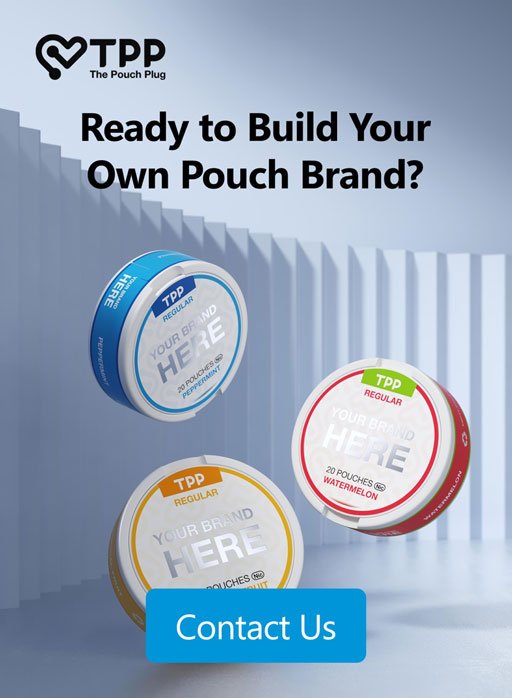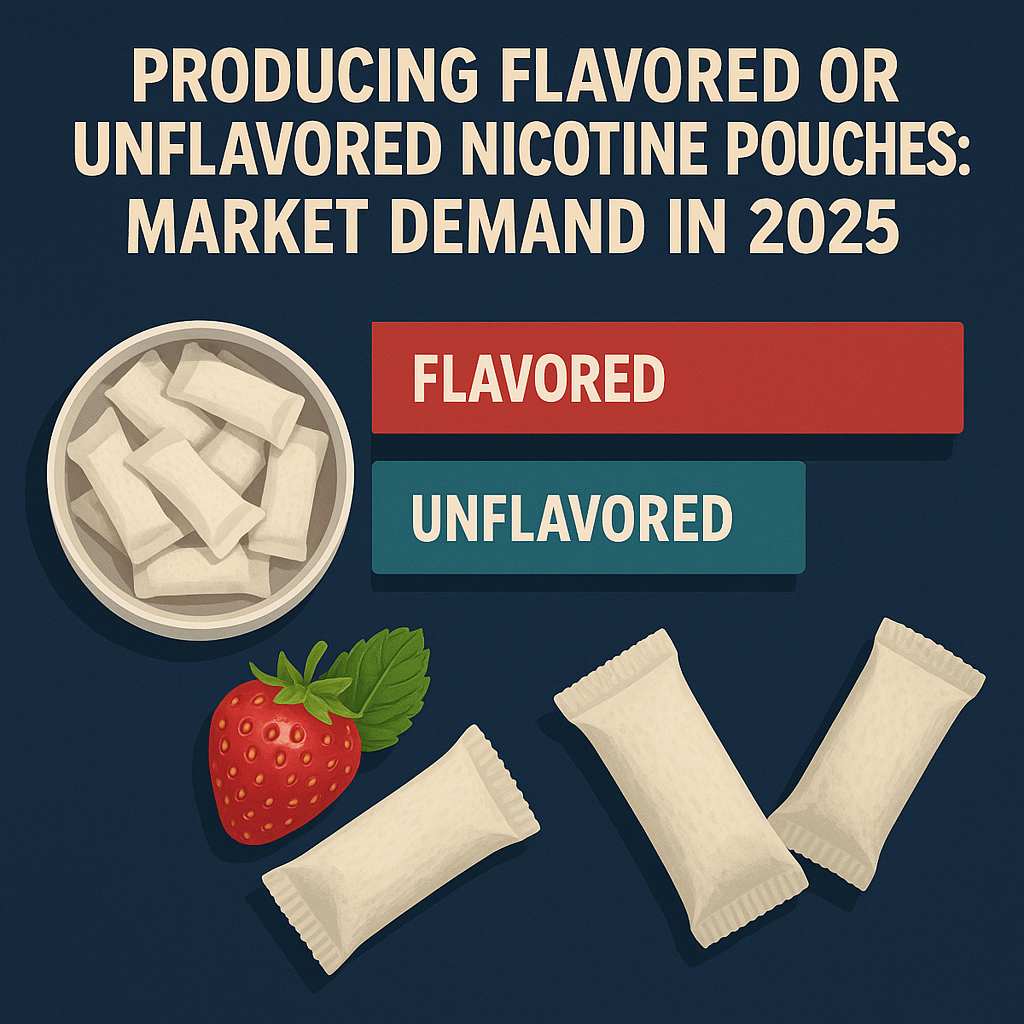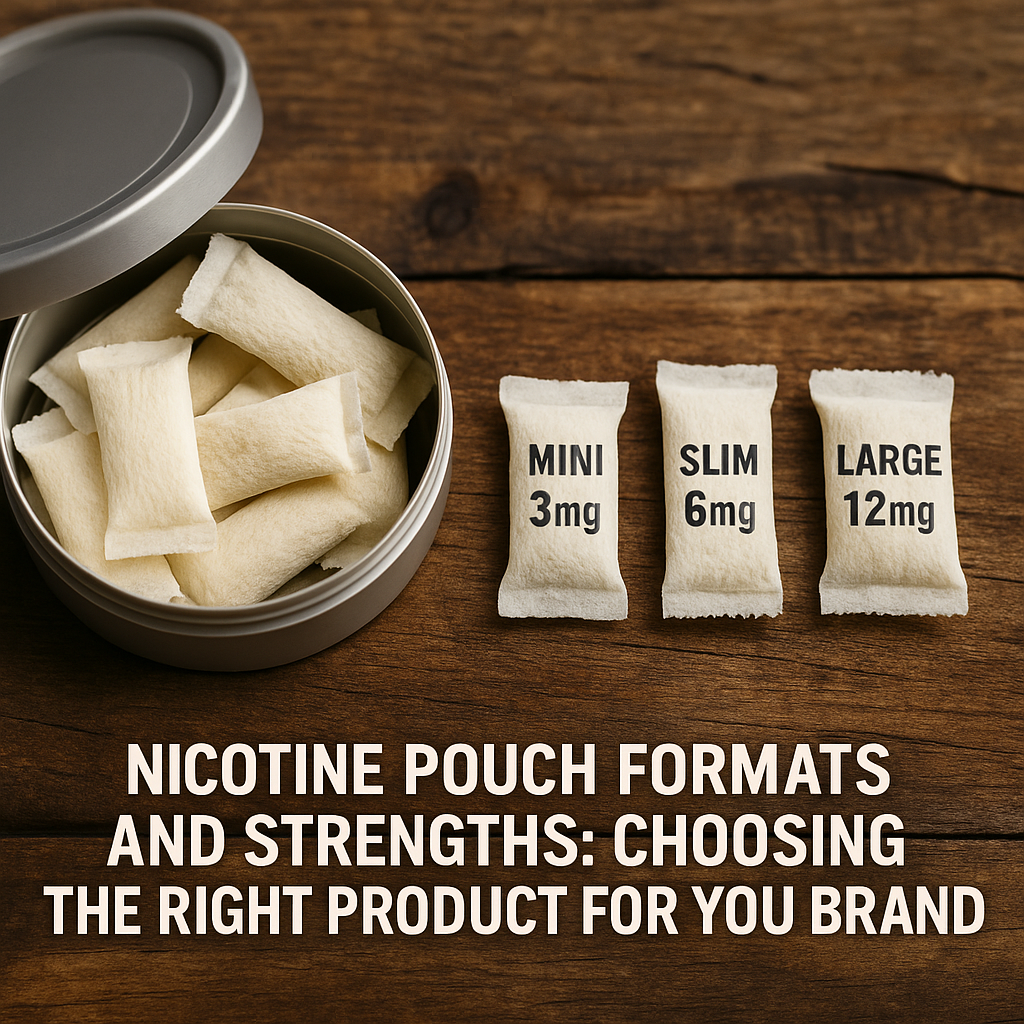Your First Big Decision: How Will You Produce Nicotine Pouches in 2025?
Nicotine pouch manufacturing – the process of blending nicotine, flavors, and fillers into oral pouches – is the most critical decision for new brands. But should you build an in-house factory or partner with a contract manufacturer?
By 2025, an astonishing 80% of startups are turning to outsourcing—but is it the right move for yours? Let’s uncover the key factors that separate those who thrive from those who regret their decision.
In-House Manufacturing: Building Your Own Nicotine Pouch Facility

Choosing in-house manufacturing means you handle everything yourself—from formulation and production to packaging and compliance.
The Appeal of In-House
At first glance, having your own production setup might sound attractive. Who wouldn’t want:
- Total control over every production step.
- The ability to fine-tune every recipe and process.
- The pride of saying “Made in Our Own Factory.”
But let’s pull back the curtain…….
The Reality Check
Running your own nicotine pouch factory is not just about control—it’s about taking on a mountain of responsibility and risk.
- Setup time can range anywhere from 12 to 36 months.
- You’ll need to secure equipment, facilities, skilled staff, and pass safety and legal inspections.
- If you’re unfamiliar with nicotine handling and quality manufacturing, you’ll face a steep learning curve.
And here’s the catch: Many companies that try this route end up losing time, money, and momentum.
They take their eyes off what they’re great at—branding, sales, and distribution—and instead struggle to become manufacturers overnight. The opportunity cost is high if things go wrong.
Key Advantages of In-House
✔ Full control over quality, scheduling, and proprietary recipes.
✔ Potentially lower cost per unit—but only at massive scale and after years of investment.
✔ Can help reinforce your brand story if done right.
Major Challenges
⚠ Huge upfront costs (ranging from hundreds of thousands to millions).
⚠ Long setup time that delays your market entry.
⚠ Requires expert knowledge in compliance, safety, and consistent production quality.
⚠ High-risk alternative if your team lacks manufacturing experience.
📌 Summary: It might look like a good idea on paper, but in practice, in-house production is a high-stakes, slow-moving, and complex path that often pulls founders away from growth-focused tasks.
Contract Manufacturing: Outsourcing to the Pros

Now, let’s look at the smarter route most modern nicotine brands take.
Contract manufacturing means you team up with an expert partner (like The Pouch Plug) who already has the facility, staff, and systems in place.
How It Works
You handle the brand—flavors, vision, and design. Your partner handles everything else—formulation, filling, testing, compliance, and packing.
This division of labor isn’t a shortcut—it’s an upgrade.
Benefits of Contract Manufacturing
✔ Minimal upfront cost — no need to lease factories or buy million-dollar machines.
✔ Speed to market — launch in weeks, not years.
✔ Expert support — work with a team that already knows the rules, the processes, and how to maintain consistent quality.
✔ Compliance made simple — reputable manufacturers stay ahead of regulatory shifts, so you don’t have to worry about inspections.
✔ Scalability — grow production as demand rises without taking on massive risk.
✔ Stay focused on growth — spend time on branding, partnerships, and customer relationships, not staff training and pH balances.
Potential Downsides (And Why They’re Manageable)
⚠ You’ll work within their processes — but reputable manufacturers offer plenty of customization.
⚠ Minimum order quantities (MOQs) apply — but they also help you scale smart and keep per-unit pricing healthy.
⚠ Less direct control — but for most brands, the tradeoff is worth it.
📌 Summary: Contract manufacturing is the go-to for startups and even experienced brands. It gives you what you need—quality, speed, safety—without the distractions and heavy burden of running a production facility.
👉 That’s why it’s not just a shortcut. It’s a business-smart decision.
Hybrid Manufacturing: The Best of Both Worlds?
Some growing brands explore hybrid models—outsourcing their core products while handling limited-edition runs or R&D internally.
How Hybrid Works
- Start with contract manufacturing to launch fast.
- Gradually bring parts of production in-house (e.g., test batches or new SKUs).
- Use outsourced production to meet bulk demand.
Pros of Hybrid
✔ Flexibility to scale and experiment.
✔ Redundancy and risk management.
✔ A chance to slowly build operational capabilities.
Cons of Hybrid
⚠ More complex logistics and coordination.
⚠ Higher management overhead.
⚠ Can distract from your brand if not handled strategically.
📌 Summary: Hybrid manufacturing can work, but it still starts with a reliable contract partner. Think of it as a Phase 2 option once your brand has traction.
Choosing the Right Path for Your Brand
Still unsure? Ask yourself:
What’s my budget?
- Tight? → Contract manufacturing lets you launch smart and stay lean.
- Deep pockets? → You can consider in-house, but contract still offers faster results.
What’s my timeline?
- Need speed? → Go contract. Weeks, not years.
- Time to spare? → In-house is possible but risky.
How much control do I really need?
- Obsessed with owning every step? → In-house.
- Want to focus on customers, growth, and strategy? → Contract.
What’s my long-term vision?
- Global scale? → Start contract, scale smart.
- Niche? → Contract manufacturing may be all you need.
Final Thoughts

Many founders dream of total control, but the smartest ones know when to delegate.
That’s why most successful pouch brands today launch (and stay) with contract manufacturing. It frees you to focus on the part that really grows your business—marketing, customer experience, and brand loyalty.
Want help turning your pouch idea into a real product?
At The Pouch Plug, we’re founded on Swedish snus expertise and have helped dozens of nicotine pouch brands launch globally with confidence.
👉 Get in touch with our team and let’s make your vision happen.
FAQs: Contract vs In-House Nicotine Pouch Manufacturing
❓1. Is it cheaper to manufacture nicotine pouches yourself or outsource?
Answer:
Outsourcing is usually cheaper since you avoid large setup costs like machinery, staff, and certifications. In-house production requires a big upfront investment. Most go with contract manufacturing to launch fast and manage cash flow better.
❓2. How long does it take to start selling if I use contract manufacturing?
Answer:
Most brands can launch within 4 to 12 weeks using a contract manufacturer, depending on how ready your product concept is. Manufacturers already have production lines, nicotine supply chains, and packaging in place, which speeds things up. This is much faster than setting up your own facility from scratch.
❓3. What’s the best option for small pouch startups?
Answer:
Contract manufacturing is perfect for small startups. It helps you test the market, scale gradually, and focus on growth. Most big brands use contract manufacturing as well, just because of the safety of leaving the manufacturing of snus production to the experts with experience.
❓4. What’s a hybrid production strategy?
Answer:
A hybrid strategy uses both contract and in-house manufacturing. You can launch fast with a contract manufacturer and bring parts of production in-house later. This balances cost, control, and scalability. It’s also helpful if you want to test limited editions or custom blends before full-scale rollout.











